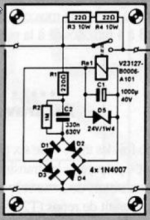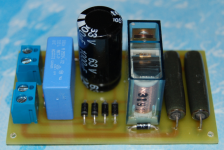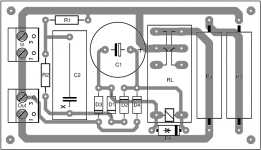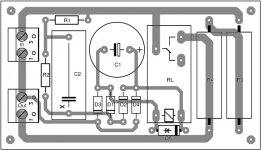Hello everyone!
I realized what softstart that works perfectly but I think the relatively short time (~ 1s), the tests were done without any transformer connected.
I do not know if we can extend it a little time and which components must be changed.
Thank you!
I realized what softstart that works perfectly but I think the relatively short time (~ 1s), the tests were done without any transformer connected.
I do not know if we can extend it a little time and which components must be changed.
Thank you!
Attachments
Last edited:
Hello AndrewT!
I use an online translator and translation of your sentence is weird.
This is a question about the circuit or the answer?
Regards!
Is this a discussion about a direct to mains circuit?
I use an online translator and translation of your sentence is weird.
This is a question about the circuit or the answer?
Regards!
This is a question about the topic being discussed.
Is the circuit connected directly to the mains?
If it is, then all discussion on this topic is BANNED on this Forum !
I can hardly believe that Tony has let this continue.
unbelievable......
I serviced an amp that had resistors pulling up a relay. Resistors where before the rectifier connected directly to mains(230V), and the cap after it gave it a short delay before clicking.
The four 5W resistors dissipated 15-20W of power and the circuit board was burned to a crisp.
I though something was wrong before I realized it was meant to work that way.
Long story short, DON'T do it that way.
Using the soft start after the transformer would be way better (and safer).
The four 5W resistors dissipated 15-20W of power and the circuit board was burned to a crisp.
I though something was wrong before I realized it was meant to work that way.
Long story short, DON'T do it that way.
Using the soft start after the transformer would be way better (and safer).
Last edited:
Mains = Directly connected to the electricity outlet, with NO transformer. That is if your electricity supply is 240V, the rectifier bridge is rectifying that 240V directly, with no step down, or isolation transformer present..
Discussion of such circuits is not allowed under the diyAudio rules.
Tony.
Discussion of such circuits is not allowed under the diyAudio rules.
Tony.
Yes but I was talking about this transformer output circuit (so no charge).The OP STATED that he had "test" ed the circuit without a transformer.
Gentlemen moderators if you think that are necessary, close this thread so unimportant.
Last edited:
I just simulated it in LTSPICE and it appears to be a 230V circuit. Is this correct?
Increasing C1 does increase turn on time as far as I can see.
If it where me I would adapt it to go after the transformer. Unless the transformer was really big. Then I would buy a real time relay.
Increasing C1 does increase turn on time as far as I can see.
If it where me I would adapt it to go after the transformer. Unless the transformer was really big. Then I would buy a real time relay.
Last edited:
Do you have an example of that?Interessted..If it where me I would adapt it to go after the transformer
Hmmm...I have a soft start circuit from a company called NewClassD that is rated for 20A and designed to go between the mains and the power transformer, right on the 120V line. Input is clearly labeled "Mains". It gives ~1 sec delay. I can't possibly put it after the B+ transformer, as that is at 2500VAC.
Are you folks saying this is unsafe?
It's similar to this one:
http://www.newclassd.com/index.php?page=80
Are you folks saying this is unsafe?
It's similar to this one:
http://www.newclassd.com/index.php?page=80
Last edited:
Is the circuit connected directly to the mains?
If it is, then all discussion on this topic is BANNED on this Forum !
Where is this rule?
I clicked on "Rules" but I don't see that.
Discussion of such circuits is not allowed under the diyAudio rules. Tony.
Why not? Too dangerous stuff?
- Status
- Not open for further replies.
- Home
- Amplifiers
- Power Supplies
- Softstart delay




 Andrew, as it has not been established whether or not this is a direct mains powered project, I feel that it is completely inappropriate to state that you can hardly believe that Tony has let it continue.
Andrew, as it has not been established whether or not this is a direct mains powered project, I feel that it is completely inappropriate to state that you can hardly believe that Tony has let it continue.